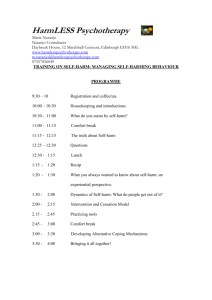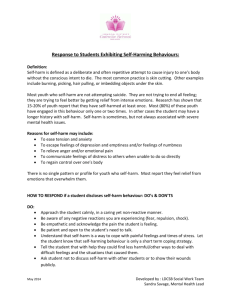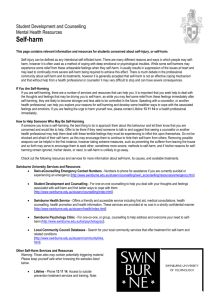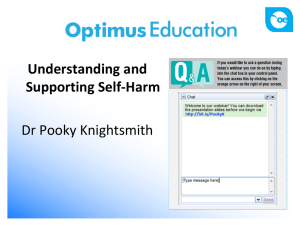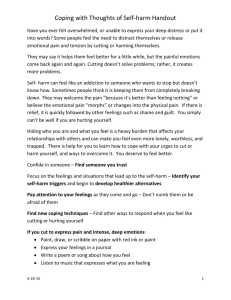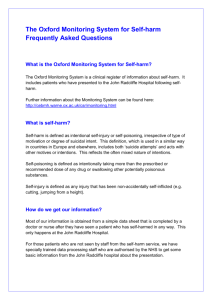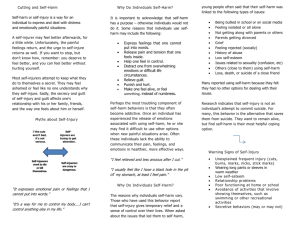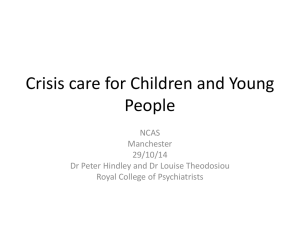Deliberate self-harm Self-harm or self
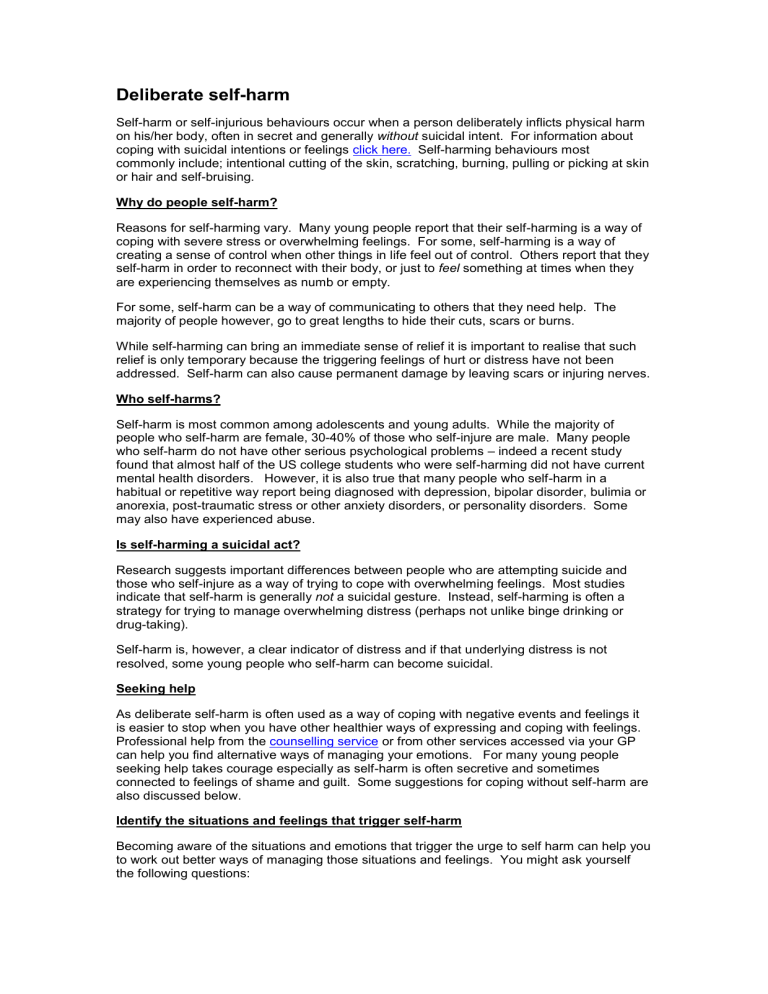
Deliberate self-harm
Self-harm or self-injurious behaviours occur when a person deliberately inflicts physical harm on his/her body, often in secret and generally without suicidal intent. For information about coping with suicidal intentions or feelings click here. Self-harming behaviours most commonly include; intentional cutting of the skin, scratching, burning, pulling or picking at skin or hair and self-bruising.
Why do people self-harm?
Reasons for self-harming vary. Many young people report that their self-harming is a way of coping with severe stress or overwhelming feelings. For some, self-harming is a way of creating a sense of control when other things in life feel out of control. Others report that they self-harm in order to reconnect with their body, or just to feel something at times when they are experiencing themselves as numb or empty.
For some, self-harm can be a way of communicating to others that they need help. The majority of people however, go to great lengths to hide their cuts, scars or burns.
While self-harming can bring an immediate sense of relief it is important to realise that such relief is only temporary because the triggering feelings of hurt or distress have not been addressed. Self-harm can also cause permanent damage by leaving scars or injuring nerves.
Who self-harms?
Self-harm is most common among adolescents and young adults. While the majority of people who self-harm are female, 30-40% of those who self-injure are male. Many people who self-harm do not have other serious psychological problems – indeed a recent study found that almost half of the US college students who were self-harming did not have current mental health disorders. However, it is also true that many people who self-harm in a habitual or repetitive way report being diagnosed with depression, bipolar disorder, bulimia or anorexia, post-traumatic stress or other anxiety disorders, or personality disorders. Some may also have experienced abuse.
Is self-harming a suicidal act?
Research suggests important differences between people who are attempting suicide and those who self-injure as a way of trying to cope with overwhelming feelings. Most studies indicate that self-harm is generally not a suicidal gesture. Instead, self-harming is often a strategy for trying to manage overwhelming distress (perhaps not unlike binge drinking or drug-taking).
Self-harm is, however, a clear indicator of distress and if that underlying distress is not resolved, some young people who self-harm can become suicidal.
Seeking help
As deliberate self-harm is often used as a way of coping with negative events and feelings it is easier to stop when you have other healthier ways of expressing and coping with feelings.
Professional help from the counselling service or from other services accessed via your GP can help you find alternative ways of managing your emotions. For many young people seeking help takes courage especially as self-harm is often secretive and sometimes connected to feelings of shame and guilt. Some suggestions for coping without self-harm are also discussed below.
Identify the situations and feelings that trigger self-harm
Becoming aware of the situations and emotions that trigger the urge to self harm can help you to work out better ways of managing those situations and feelings. You might ask yourself the following questions:
1. What am I doing when the urge to harm arises? Are there any common themes/situations? Where am I when it arises? Does it occur after interactions with the same people, after the same type of events?
2. How am I feeling just before I want to injure myself?
Sometimes people choose to keep a dairy so that they can better understand the triggers to their self-harm.
People who self-injure sometimes report that it is hard for them to identify what they are feeling. Learning how to identify and label emotions involves starting to notice the three components of emotion – bodily sensations, thoughts and actions/urges. For example, if you pay attention to your experience you might notice:
Anger Fear Sadness
Bodily sensation trembling, sweating
Thoughts shortness of breath tight muscles
“its not fair” “its too awful/threatening” heaviness in chest, exhaustion
“its hopeless”
Actions/urges argue Run, avoid give up, cry
Delay and distraction strategies
Just delaying the urge to self-harm for several minutes often helps the wave of distressing feelings subside and become more manageable. Different strategies work better for different feelings – for example if you are angry running might help, if sad you might talk to a friend or listen to soothing music. A number of these alternatives are listed below
Feeling angry
Dance
Clean house
Exercise
Run
Jump
Ride your bike/swim
Yell or sing at the top of your voice -
(into your pillow if you share a house!)
Work in your garden
Feeling frightened or overwhelmed
Break down tasks that need to be done into very small steps
Take one step at a time
Start with the least scary step
Talk with a friend
Use mindfulness and grounding strategies
(see below)
Feeling sad or depressed
Listen to soothing music
Light soothing incense
Visit or phone a friend
Play with your pet
Curl up in your doona with a good book
Have a cry
Draw, paint or write in a journal
Have a hot bubble bath or shower
Talk with a friend
Do something kind for an other person
Watch a feel-good movie
Feeling empty or unreal
Interact with other people
Focus on how it feels to breathe - notice the movements of your chest and abdomen with each breath
Stomp your feet on the ground
Chew ginger or bite a hot pepper
Use grounding strategies (see below)
Grounding and mindfulness strategies
We can get stuck in painful emotional states because we judge them to be permanent and an inherent part of who we are. It is helpful to see emotions as rising and falling with each moment of experience like a wave ebbing and flowing. Use your breath as an anchor to keep your focus grounded rather than getting carried away by your emotional state. Here is an exercise that may help you to learn how to step back from turmoil.
Take ten breaths
Throughout the day, pause for a moment and take ten slow, deep breaths. Focus on breathing out as slowly as possible, until the lungs are completely empty, and breathing in using your diaphragm.
Notice the sensations of your lungs emptying and your ribcage falling as you breathe out. Notice the rising and falling of your abdomen.
Notice what thoughts are passing through your mind. Notice what feelings are present. Notice what physical sensations are in your body and what action urges you are experiencing.
Observe your thoughts, feelings, physical sensations and action urges without judging them as good or bad, and without trying to change them, avoid them or hold onto them. Simply observe them.
Notice what it’s like to observe thoughts, feelings, physical sensations, and action urges with an attitude of acceptance rather than reacting to them with your usual habits and patterns. (from Learn To Manage Uncomfortable Feelings )
For information and exercises on mindfulness explore the ThinkMindfully website.
Further grounding strategies
Grounding exercises help you focus your attention on the present moment. They are helpful whenever you are having an experience that is overwhelming, or that is absorbing all of your attention. Grounding exercises help you to "snap back into reality" relatively quickly.
Try the following:
1) 5-4-3-2-1 : This technique makes you aware of things in your environment and helps you calm down and realise that you are safe. Say 5 things you can SEE around you, then say five things you can HEAR around you, then say 5 things you can FEEL touching the outside of you body. Then repeat this process with 4 things, then 3 things and so on. It doesn’t matter if you repeat the same thing or get out of order. It seems to help most when you say it out loud (even quietly).
2) Look around you : Catalogue the things you see. Notice even the small details (e.g., the light switch is cream and a little crooked). Trace the details in the room with your eyes like you would if you were tracing using a pencil without lifting it from the page.
3) Listen : Listen to the sounds you hear around you. Notice the obvious sounds and then the layers of sound (e.g., the sounds behind the sounds). Notice them rise and fall, their pitch and tone
Other alternatives to deliberate self-harm
Below are some other strategies that people have found useful in emergencies – they are safer strategies than engaging in self-harm but are not longerterm solutions, as they don’t really address the thoughts and feelings triggering self-harm. If you find yourself using these strategies often – it may be time to seek some professional help.
hold an ice cube or rub it over your wrists or parts of your body where you self-injure
snap a rubber band worn loosely around your wrist/arm
have a cold shower
eat a chilli or something really hot
put a liniment like Vapour Rub or Deep Heat under your nose (it stings and makes you cry)
punch a pillow or punching bag
wax your legs
draw or write all over your body in red ink (rather than cutting).
scribble down your negative thoughts on paper in red pen and then tear up the paper
(Source: http://au.reachout.com/find/articles/deliberate-self-harm )
How do I help a friend who self-harms?
If you are worried about your friend but not sure if they are selfharming don’t be afraid to ask.
Here are some tips that can help:
Make sure that you talk to them in a private setting and be respectfully curious – asking gentle but clear questions about what he/she might be experiencing.
Often we are reluctant to raise the topic for fear that our friend will either be angry or that our questions might cause them to start harming if they wer en’t already doing so.
It is important to know that many studies indicate that people who self-injure actually wish that someone would raise the subject (even if they respond angrily at first).
Asking questions that show genuine care and concern for a friend will also not cause them to start self-harming.
Try to understand and listen to your friend without judging them or setting ultimatums, but don’t promise to keep secrets about their behaviour.
Encourage your friend to seek help from the counselling service, their GP or a trusted adult, to use alternatives to self-harming, and support them taking the steps to do so.
If you find yourself feeling overwhelmed or exhausted by your friend’s behaviour – take a break – be honest with your friend about your own limits – and encourage them to seek assistance.
It is also important to understand that sometimes people are not ready to get help and that if your friend rejects your input you have not failed.
Remember, self-harming itself is not an indication of suicidal tendencies. However, if you think that the situation is very serious or life threatening don’t hesitate to get help. You are not betraying your friend if you get them the assistance that is really needed. You can speak to a counsellor , your friend’s parents, the residential advisor or Principal (if you live in college). For more information see Cornell University’s fact sheet on aiding a self-injuring friend.
Sources for this page and further resources
Contact Kids help line 1800 55 1800 or Lifeline on 13 11 14 to talk to someone 24hours.
Living if for everyone LIFE has a fact sheet (number 8) on deliberate self-harm and suicide
Cornell University’ s information and research site on deliberate self-harm
Counselling website resources such as the Learn To Manage Uncomfortable Feelings
Reach Out website’s material on deliberate self-harm
Individual Assistance for the Counselling Service
If after accessing these resources you still need some further help please make an appointment with one of our counsellors at the Counselling Service or see your doctor who can provide assessment and referral to resources in your local area.
